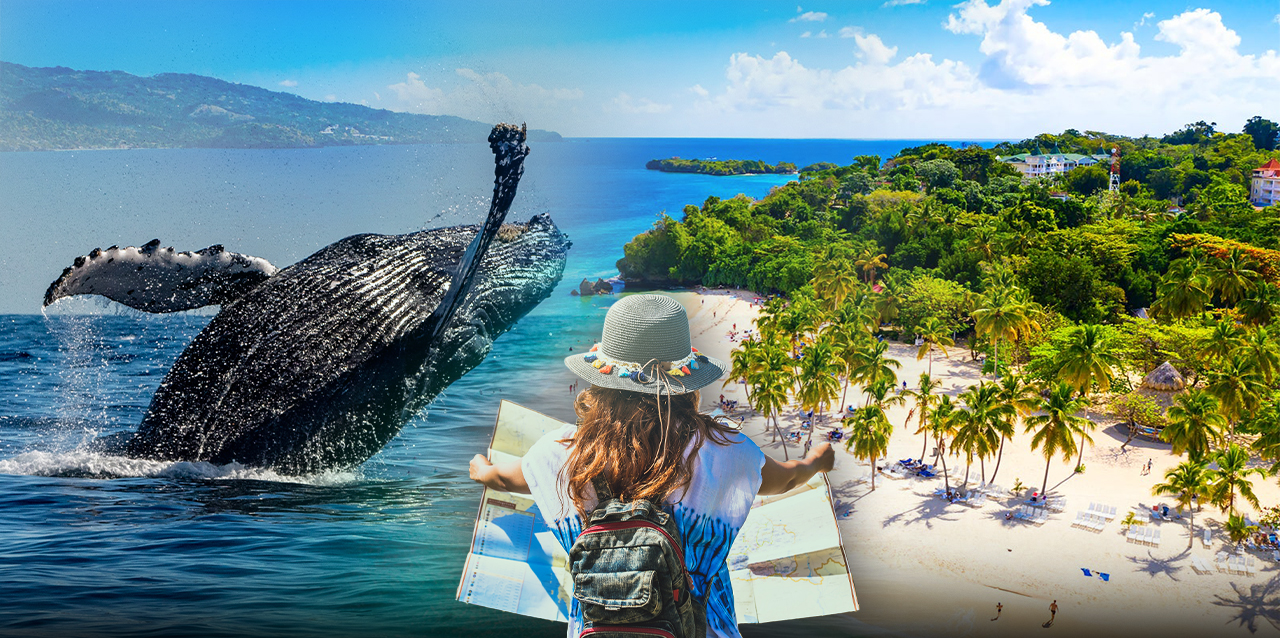The beginning of the year gifts us with an extraordinary spectacle: thousands of humpback whales arrive in Samaná, in the northeastern Dominican Republic, dazzling us with their acrobatics, breaches, tail slaps, and melodic songs. Witnessing this phenomenon is an experience worth having at least once in a lifetime.
1.Why Do Humpback Whales Come to Samaná?
Humpback whales undertake two long annual migrations: they travel to cold polar waters in the summer to feed and return to warm tropical waters in the winter to reproduce.
The warm, sheltered, and shallow waters of Samaná provide a safe and comfortable environment for the whales during their stay. This tropical refuge becomes a distant home where whales can carry out their mating rituals and care for their calves without worry.
2. Whale Watching in Samaná
Samaná, a paradise in the Dominican Republic, not only dazzles with its dreamlike beaches but also offers a unique experience: whale watching. Immerse yourself in the majesty of Samaná Bay's waters and witness the breathtaking show performed by the imposing humpback whales in their natural habitat.
The Dominican Republic proudly stands as one of the premier destinations for whale watching. Each year, about 2,000 whales migrate from the North Atlantic to the warm waters of the Caribbean Sea in Samaná Bay and Banco de la Plata.
If you're planning your next getaway to the Dominican Republic, make sure to include a whale-watching excursion in Samaná on your itinerary.
Whale-watching tours in Samaná are an unmissable opportunity to explore marine life at its best and witness the tail slaps, breaches, and songs of these ocean giants up close. In this Caribbean paradise, humpback whale watching has become an iconic activity, attracting nature lovers and adventurers from around the world. Expert local guides will take you to the best viewing spots, ensuring an unforgettable and respectful marine wildlife experience. This adventure is sure to be the highlight of your trip.

2.1. Whale Watching Season and Dates
The whale-watching season is the most exciting time of the year in Samaná, Dominican Republic! The 2024 Whale Watching Season in Samaná began dazzling us with its marine splendor, so get ready to dive into the fascinating world of humpback whales!
2.1.1. Whale Watching Dates in SamanáWhile some whales start arriving as early as November and others leave in April, the observation season offers the best chance to see them.
The Whale Watching Season in Samaná is known for offering one of the Caribbean's most impressive natural spectacles. This phenomenon occurs every year from mid-January to late March, with February being the peak month. During this period, Samaná's waters are filled with the majesty of humpback whales, captivating us with their acrobatics and characteristic songs, drawing nature enthusiasts and curious visitors alike.
2.1.2. Dominican Republic Whale Watching Season 2024Mark your calendar for the key dates of the 2024 whale-watching season in Samaná. From January 15 to March 20, embark on a unique experience, marvel at the majestic presence of humpback whales, and create unforgettable memories in this paradisiacal corner of the Dominican Republic. Get ready to experience the magic of the whale-watching season in Samaná!

3. Whale Sanctuary in Samaná
If you visit Samaná outside the whale-watching season or simply wish to learn more about these fascinating marine animals, consider exploring the Whale Museum in Samaná.
In 1986, the Dominican Republic created the Silver and Navidad Banks Marine Mammal Sanctuary, a significant protected area. This sanctuary is dedicated to the conservation and protection of various marine mammals, including humpback whales, dolphins, and manatees, which use these waters as their habitat during different times of the year.
Within the sanctuary, regulations and conservation measures are in place to preserve the marine environment and ensure the safety and well-being of the mammals. Activities such as whale watching are regulated to minimize any negative impact on the animals.
It stands as a remarkable example of regional conservation efforts to protect marine biodiversity.
4. Seven Facts About Humpback Whales
- Humpback whales are not fish but mammals. The difference between aquatic mammals and fish is easy to spot: fish have vertical tails, while aquatic mammals have horizontal ones. Additionally, they give live birth instead of laying eggs and seek warm tropical waters for this process.
- They can grow over 15 meters long and weigh more than 30 tons, while calves are about 4 meters long and weigh up to one ton.
- They obtain oxygen through a blowhole on top of their heads, and although they can stay underwater for up to 30 minutes, their dives typically last about 15 minutes.
- When a whale surfaces after holding its breath, you can hear its exhalation before it inhales and dives again. A humpback whale's exhalation can reach heights of up to 3 meters.
- They are called humpback whales because when they arch their bodies before diving, a distinctive hump is visible on their backs.
- They feed on small marine organisms like krill and small fish, and their throats are not large enough to swallow anything the size of a human.
- Only males sing, and their melodies can last up to 20 minutes

Source: Lets go Rd
https://letsgord.com/


